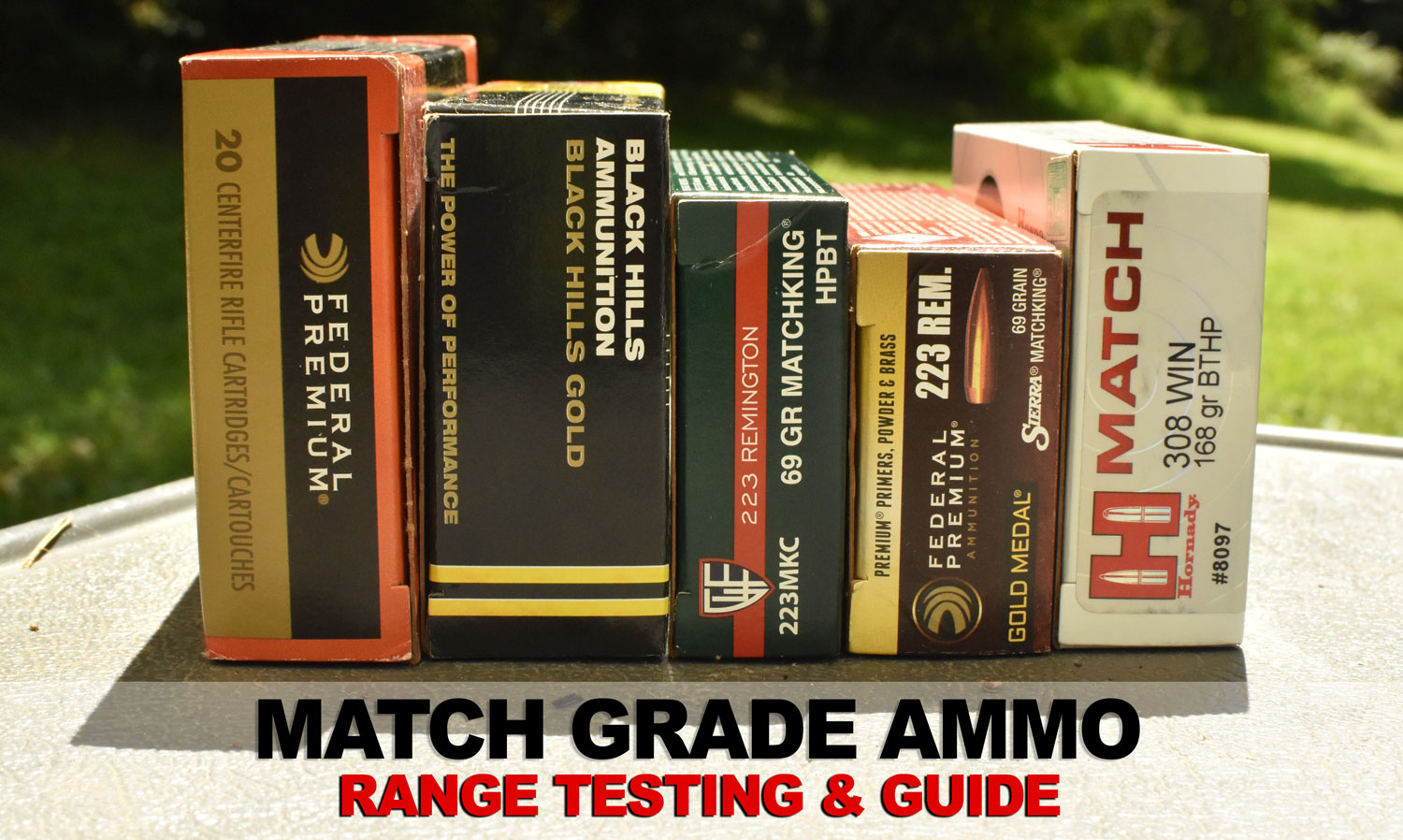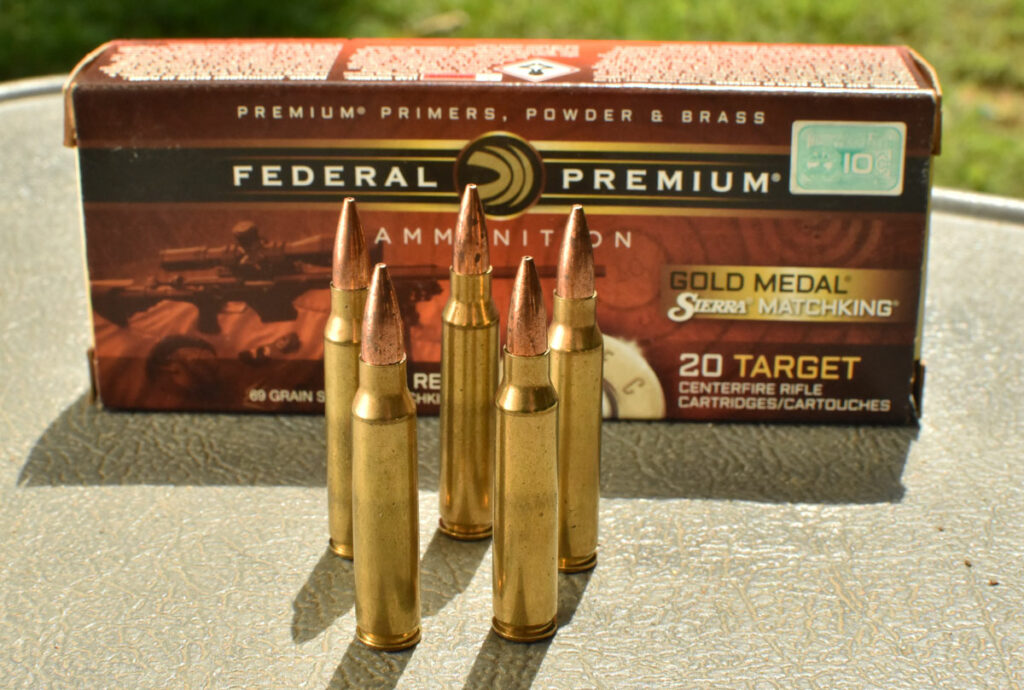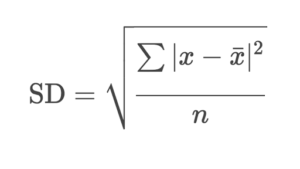Is match grade ammo worth the extra expense? Let’s test some rounds with rifles and see what we can come up with!
My grandfather always said, “You get what you pay for.” His sage advice holds up in almost every situation. But does it hold-up when we talk about match grade ammo?
We hit the range to get an answer, pitting premium-priced “Match” ammo against standard factory rounds. (We even threw in some bargain priced training ammo just to see if price equals performance.) You might be surprised at the results.
What is Match Ammo?
The basic definition of match grade ammo is “ammunition suitable for a competitive match.”
Generally speaking, match ammunition is designed to be more consistent and accurate than cheaper general-use ammo.
Ammo makers achieve this consistency through tight tolerances and strict quality control. Generally speaking, the controls are more rigorous for this ammo to get put in a box and sold than cheap bulk loads.
You might find powders that burn more consistently along with higher quality (and more expensive) primers in match ammo.
Match grade rifle ammunition may also feature specialized bullet designs like a boat tail and an open tip. These bullet features help reduce drag to improve aerodynamics. These features can increase accuracy.
The Problem With the “Match” Label
Unfortunately, the ammunition industry has no universal criteria that must be met for a cartridge to wear the “match” label. Instead, it is up to each individual manufacturer to set their own standards. These standards can vary greatly. Some manufacturers label their match ammo based on the projectile design alone. Others use specialized primers or powders to achieve high-level consistency.
The only surefire way to know what any given match load is capable of is to take it to the range. So, that’s exactly what we did.
Match Grade Ammo Testing
We wanted to approach this project as scientifically as possible. Full disclosure: none of the “researchers” in our group has a degree in math or physics. We are just regular joes that love to shoot. (The closest thing to a “professional” was an active duty Army infantry soldier and a qualified Expert Marksman.)
There are a ton of variables that can affect ammunition performance. We did our testing on a standard gun range rather than a cold sterile laboratory test room.
Our results also admittedly come from a rather small sampling. (We used two different shooters, each shooting five rounds of each load.) If this test were replicated on a broader scale in a more controlled environment, the outcome could be vastly different.
Equipment Used
We also wanted the data to be useful to the average shooter, so we chose practical inexpensive firearms to use for testing. We used a factory standard Remington Model 700 SPS Tactical with a 23-inch barrel and a custom-built AR-15 platform. The AR was built to standard specs, with a 16-inch barrel, and no fancy tactical bells or whistles.
We set a to use basic and affordable weapons that are readily available to everyday shooters, no matter their budget or skill level.
For testing, we used a Caldwell Ballistic Precision Chronograph Premium Kit to measure velocity.
We recorded hundred-yard groups to represent natural shot dispersion from a central point-of-impact. It is important to note that variations in velocity will have minimal effect on shot groups at 100 yards. However, using the mysterious powers of math, we can estimate group sizes at longer distances. Seemingly small inconsistencies at 100 yards will have a huge impact on precision at 300, 400, 500 yards and beyond.
We used a basic American-made 3-9×40 scope with a first focal plane reticle for magnification. We also used sandbags and a bipod to aid shooter stability. However, we need to note, there was plenty of room for shooter error in our methods.
What The Numbers Mean
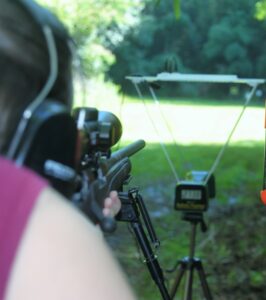
Average Velocity
This number is pretty easy to understand. Not really all that important for determining consistency, the average velocity is essential for calculating standard deviation (which is crucial to understanding ammunition consistency).
Extreme Spread (ES)
One of the most basic measurements in ammunition performance, extreme spread is the highest recorded velocity minus the lowest recorded velocity in a string of shots. Ammunition that is consistently loaded with consistent components should produce a lower ES. However, ES isn’t the best measure of consistency. One cartridge that produces a velocity well outside the average velocity of the group can create a larger ES. Therefore, the better measure of consistency is standard deviation.
Standard Deviation (SD)
To quantify the amount of variation in velocity, it is necessary to calculate standard deviation. In very basic terms (for those of us who are math challenged), SD indicates how spread out the numbers are from the average. The lower the SD, the more consistent the ammunition shoots.
Here is the formula for calculating SD.
If this looks daunting, don’t worry. We’ve done all the heavy math lifting for you.
Precision In Inches
To estimate “accuracy” for each load we measured the diameter of each shooter’s shot group for each load we tested. We calculated the average spread for each test load and recorded it in the table below.
Precision Versus Accuracy
Before diving into the test data, let’s take a moment to distinguish between precision and accuracy.
Accuracy refers to how well shots are centered on a target. While accuracy is important, it isn’t essential in this test.
Precision is the spread of shots around the center point of a shot group. By focusing on the spread of our groups around a central point rather than around the “bulls-eye,” we can better measure the consistency of the ammunition. If the ammo performs consistently, we can eventually achieve accuracy, usually by adjusting the optic. However, precision can’t be adjusted with the simple turn of a dial.
Our Test Results
|
.308 Winchester Ammunition |
Average Velocity in fps |
Extreme Spread (ES) |
Standard Deviation (SD) |
Precision in Inches |
| Prvi Partizan 165gr. Pointed Soft Point | 2738 | 78 | 25.5 | 2.5 |
| Wolf WPA 145gr. FMJ | 2804 | 146 | 55.2 | 3.63 |
| German Military Surplus 148gr. FMJ | 2865 | 221 | 58.7 | 1.5 |
| Federal American Eagle 150gr. FMJ-BT | 2895 | 79 | 21 | 2.88 |
| Prvi Partizan 168gr. BTHP Match | 2734 | 78 | 15.2 | 1.25 |
| Federal Gold Medal Match 175gr. BTHP | 2630 | 115 | 41.8 | 1.75 |
| .223/5.56 Ammunition |
Average Velocity In fps |
Extreme Spread
(ES) |
Standard Deviation
(SD) |
Precision in Inches |
| American Eagle MSR 55gr FMJ | 3045 | 102 | 25.8 | 2.63 |
| Winchester Target M855 62gr. | 2991 | 137 | 46.6 | 1.75 |
| Federal Gold Medal 77gr. MatchKing BTHP | 2649 | 87 | 32.6 | 3.06 |
| American Eagle 75gr. TMJ | 2546 | 63 | 21.4 | 2.16 |
| Tula 75gr. HP | 2368 | 74 | 27.4 | 3.25 |
| Winchester Match 77gr. HPBT | 2682 | 36 | 13.3 | 1.75 |
| Black Hills 77gr. Open Tip Match | 2726 | 52 | 18.4 | 2.5 |
Get our raw Match Ammo Testing Data here.
What is Ballistic Coefficient?
Ballistic Coefficient (BC) is the measure of a bullet’s aerodynamic performance. The more streamlined a projectile, the better it cuts through the air. We can use math to calculate ballistic coefficient by comparing the bullet’s sectional density to its coefficient of form. Typically expressed as a ratio, the higher the BC, the more efficiently it cuts through the air on its way to the target. More aerodynamic projectiles will be more consistently accurate and have a larger BC.
This is why some of the above ammunition performed better on target despite large variations in velocity. The BC of a bullet design will greatly affect precision, especially at ranges beyond 100 yards.
If you take a look at the most precise groups we had at 100 yards, most featured projectiles with a boat tail hollow point design. This design is well-known for resisting drag and delivering consistent long-range accuracy. (The exception to this in our test data was the Federal Gold Medal .223 Remington ammunition. It is possible that the small sampling of data or shooter fatigue contributed to the poor results we recorded. A larger sampling could conceivably disprove our findings.)
The Numbers Game
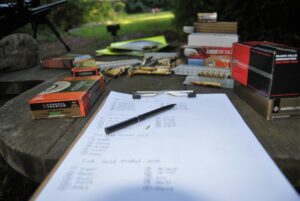
However, the “Match” label did not seem to hold up when it came to Federal Premium Gold Medal ammunition in either .223 Remington or .308 Winchester.
The load that produced the tightest shot groups in our testing were PPU Match HPBT .308 Winchester. This was the clear winner with an average group of just 1.25 inches. When you pair this consistency with the load’s consistent velocities, PPU Match should hold true even at extreme distances.
We are officially declaring the Prvi Partizan the winner of our small test group in .308 with the Remington 700. Who would have thought it, right?
In a close second is the Winchester Match HPBT .223 Remington. Consistent velocities and tight shot groups are proof of this load’s reliable performance (at least with this small collection of data).
While we did see some surprising accuracy from the German Surplus FMJ .308 and Winchester Target FMJ .223, these loads had huge SD, suggesting shot groups would spread significantly at longer ranges.
While our two best performers proudly sport a “Match” label, the label itself does not seem to guarantee consistency or precision. Otherwise, we should have recorded better numbers from the Federal Gold Medal loads.
Is Match Grade Ammunition Worth It?
With all that being said, you may still be wondering, “Is premium match grade ammunition worth the premium price?”
Well… it depends.
Like so many things in the world of shooting, there is no clear cut answer. You should consider what you’re going to use the ammunition to accomplish. After all, ammo is just a tool and some tools are better suited for some jobs than they are for others. For example, you wouldn’t want a surgeon using a meat cleaver to perform open-heart surgery. Ultimately, a meat clever and a surgeon’s scalpel are both cutting tools, but each is best suited for a specific type of cutting job. It’s the same for ammunition.
For Competition
For competition shooting, where repeatable precision accuracy is essential for high scores, you need high quality ammunition. Even the smallest variances can have a huge impact on your final score. True match grade quality ammunition is crucial for success in these highly competitive arenas.
For LE/Military
Law enforcement and military snipers also require surgical precision when it comes to their ammo. Lives depend on accurate shots, often at extreme distances where the slightest fluctuation in performance could have disastrous consequences.
If you are an amateur recreational long-range shooter who gets a major thrill out of busting bulls-eyes, you might be willing to fork out the extra cash to fund your hobby. I’m certainly not going to judge anyone based on how much they spend on ammunition.
For most shooting applications, however, paying the premium probably isn’t practical. The needs of the average hunter or recreational shooter are easily met with less expensive ammunition, so long as they choose loads that are reasonably reliable and accurate.
It is also important to keep in mind the term “match grade” has no accepted standard in the ammunition industry. It is often used as a marketing tool to get shooters to spend more money without producing measurably better results. If you want to find true match quality ammunition, spend some time at CMP, USPSA, or Precision Rifle competitions and see what the shooters use. And if you want true precision ammunition, you can always load your own.
Other Things to Consider
There is more to precision shooting than just your ammunition.
The Quality of Your Firearm
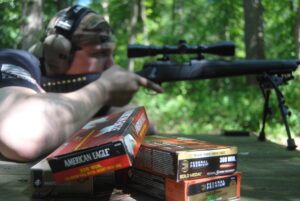
Some weapons may actually have a “favorite” ammunition. In other words, they just seem to perform better with one particular load.
You will probably find you get the best performance out of a high end competition weapon when you load it with premium ammunition. Think of these firearms like luxury cars. You wouldn’t want to pump cheap 85 octane into a Lamborghini Gallardo. You could actually damage a vehicle with cheap gasoline. The same is true of expensive firearms. Feed them quality ammunition, and they will be good to you for years to come.
The Quality of the Shooter
It doesn’t matter how fancy and expensive the firearm or ammunition is if it isn’t in the hands of a capable shooter. Don’t expect high-priced match ammo to magically make you a better shooter. There is no shortcut to mastery. Not even with fancy ammo. Practice the basics (and then practice them some more) if you want to be an accurate shooter.
Summing It Up
Take this article as permission to spend some time on the range. Use that time to practice the basics of consistent shooting form. In addition, spend some time testing different loads to see what produces the best results from your particular firearm. There are a plethora of variables out there and it is impossible to recommend a “best” ammunition for every shooter, weapon, and application. Feel free to use our results as a starting point and share your personal results in the comments.
